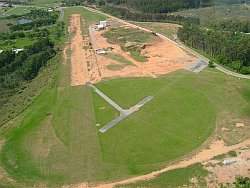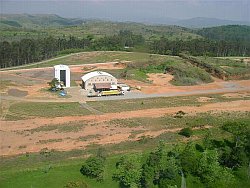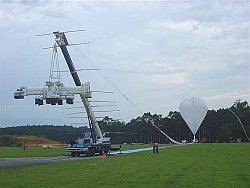The National Institute of Space Research (Instituto Nacional de Pesquisas Espaciais or INPE) unit in Cachoeira Paulista was established in 1970. The idea was to gradually transfer there all the technical and scientific activities taking place in Sao Jose dos Campos, especially taking account that those installations were temporarily ceded by the Technical Space Center (CTA). The government proceeded to expropriate a field of about 10 km2 located in a rural area which offered an environment less saturated with radio waves and artificial lighting being ideal for this purpose. There is established in 1973 the Image Production Laboratory, designed to process data obtained by satellites. However, the initial plan of moving gradually from Sao Jose dos Campos was abandoned, so the headquarters remained there while Cachoeira Paulista was used in turn for operational activities, including the launch of stratospheric balloons for which purpose was created within the site, the Balloon Launch Center.
The scientific ballooning in Brazil dates back to 1968 -when was created the stratospheric balloon launch division called "Setor de Lançamento de Baloes" (SLB)- initially the flights were made by campaigns from alternative sites such as airports like Birigui, Poços de Caldas, Resende, Fortaleza or the military base in Guaratinguetá but were mostly centralized in São José dos Campos. While the administrative headquarters and technical support units remained there, since 1980 the balloon launches are performed in the facilities located in Cachoeira Paulista.
Infrastructure
Through the years the facility suffered several changes and improvements. Their main charcteristics today are as follow.
The launch pad is composed of a flat grass circular area nearing 400 metres in diameter, well suited for operations with medium size balloons (up to 300,000 m3 of volume) and enough room to use the dynamical or semi-dynamical techniques to perform the launchings. At left can be seen an aerial shot of the launch area including the concrete runways recently added for a better circulation of launch vehicles in wet seasons (click to enlarge).
Two specific vehicles are available for that purpose: a truck crane which has a 7-meter height arm that holds the scientific instruments so they are not damaged during the launch and a spool vehicle with two spool systems, one for balloons less than 600.000 m3 and other for up to to 1.500.000 m3.
On regard the buildings, exists two hangars that can be used for the flight preparation, integration and assembly of the scientific payloads and flight trains as can be seen in the aerial image at right (click to enlarge). The last building in the area (not shown here) is the Telemetry building, used to receive scientific data and to control the flight.
For tracking of the balloon flights, two systems are used, an on-board GPS whose data is transmited through a telemetry link and mainly used for the recovery teams during the descent phase and a FSK transmitter which operating in 165,55 MHz is used as a beacon. Aditionally an airplane owned by INPE follows the balloon once it reach float altitude and up to the moment of the payload impact on the ground, ensuring a safe termination procedure. In the airplane a Doppler direction finder receiver is used to detect the beacon and to locate the payload, in case of any problem with the GPS link.
On regard the Command and Telemetry System, both works in L-band. For Command it include an exclusive operational TC channel, 3 scientific asynchronous channels while for Telemetry the system includes an exclusive operational PCM channel, an exclusive Housekeeping asynchronous channel, 4 scientific asynchronous channels, and a scientific synchronous channel.
A second TC/TM system operates in UHF and P-bands based on FM transmiters with subcarriers channels (IRIG Proportional Bandwidth) and a specific housekeeping channel that sends all the information of the telemetry system and the GPS receiver data that is used for to plot the trajectory during the descent phase.
The flights are conducted there from November to March and have a duration of between 6 hours and two days depending on the strength of the winds, which usually blow in this time of year in East-West direction. The scientific payloads are recovered generally in the west side of the state of Parana.
Since its inauguration there were over 40 launches of stratospheric balloons of various sizes, for several universities in Brazil. Also through international cooperation the SLB has carried out joint campaigns with NASA, the French Space Agency (CNES), the Japanese space agency (JAXA) and scientific institutions around the world.
Great part of the recent improvements in the infrastructure mentioned up above were made between late 2005 and early 2006, under an agreement signed between INPE and JAXA. The agreement provides for the implementation of several launches of large-size balloons designed to carry experiments developed by Japanese universities. However, until now only one flight was succesfully performed in 2006.
Since then, leting aside the inteded campaign -finally cancelled- to launch the Japanese FITE telescope in 2010, the base has been inactive.
Table of balloons launched from Cachoeira Paulista -Incomplete-
| Date | Hour | Flight Duration | Experiment | Payload landing place or cause of the failure |
|---|---|---|---|---|
| 3/29/1980 | 02:00 | 14 h | SOURCE TELESCOPE | In Capivari, Sao Paulo, Brazil |
| 4/3/1980 | 00:05 utc | 14 h 30 m | DOUBLE PROBE ELECTRIC FIELD DETECTOR | --- No Data --- |
| 4/9/1980 | 5:15 utc | 11 h | DOUBLE PROBE ELECTRIC FIELD DETECTOR | --- No Data --- |
| 11/19/1980 | 09:25 utc | 7 h 40 m | PEROBA (Plataformas Experimentais com Rastreio Orientado para BAlões) | In Maria da Fe, Minas Gerais, Brazil |
| 2/23/1982 | --- | SCAP 2000 | --- No Data --- | |
| 3/5/1982 | --- | SCAP 2000 | --- No Data --- | |
| 11/19/1982 | 17:16 | --- | RADIOMETER 90 GHZ | Found after two years in a forest in Tapiraí , Sao Paulo, Brazil |
| 11/24/1982 | 02:58 | 10 h | X-RAY DETECTOR | In Tomasina - Parana. |
| 3/25/1983 | 03:42 | 10 h | UTIC 83 (University of Tasmania / Imperial College 1983) | In Fazenda Sao Jose, Itaí (SP), Brazil |
| 12/20/1983 | 01:52 | 11 h | GAMMA RAY SPECTROMETER | In Santa Fe do Sul, Sao Paulo, Brazil |
| 3/28/1984 | --- | ELECTRIC FIELD | In Itapenininga - Sao Paulo. | |
| 3/22/1985 | 06:12 | 8 h | PULSAR | In Sapopema - Paraná |
| 3/27/1985 | 04:30 | --- | ELECTRIC FIELD | In Astorga - Paraná. |
| 11/1/1986 | 09:00 | 18 h | PAYLOAD UNKNOWN | In Leme - Sao Paulo. |
| 12/2/1986 | 21:05 | 12 h | ELECTRIC FIELD | In Cunha - Sao Paulo. |
| 12/11/1986 | 04:53 | 14 h | ELECTRIC FIELD | In Paranavaí - Paraná. |
| 12/16/1986 | 07:36 | 3 h | PULSAR | In Piracaia - Sao Paulo. |
| 2/3/1988 | 16:00 | 6 h | X-RAY AND GAMMA TELESCOPES | Payload lost. |
| 12/13/1989 | 9:20 | 11 h | ELECTRIC FIELD MEASUREMENTS | In Mogi Guacu, Sao Paulo, Brazil |
| 12/22/1989 | 22:40 | 11 h | SUPERNOVA 1987 A OBSERVATION | In Fazenda Sao Carlos - Nioaque - Minas Gerais. |
| 3/13/1990 | 09:08 | 23 h | MAGNETIC STORM OBSERVATION | In California, Paraná, Brazil |
| 11/14/1990 | 00:30 | 30 h | SUPERNOVA 1987 A OBSERVATION | In Meridiano, Sao Paulo, Brazil |
| 11/29/1990 | 00:21 | 12 h | WELCOME I | In Ribas do Rio Pardo, Mato Grosso do Sul, Brazil |
| 11/19/1991 | 01:50 | 14 h | WELCOME I | In Sao Manuel, Sao Paulo, Brazil |
| 12/3/1991 | 06:55 | 10 h | WELCOME I | In Itirapina, Sao Paulo, Brazil |
| 1/26/1994 | 7:20 local | 8 hr 20 m | DOUBLE PROBE ELECTRIC FIELD DETECTOR | --- No Data --- |
| 2/1/1994 | --- | DOUBLE PROBE ELECTRIC FIELD DETECTOR | --- No Data --- | |
| 12/20/1994 | 5:30 utc | 8 h 55 m | TIMAX (Telescopio Imageador de Raios X) | --- No Data --- |
| 3/23/1995 | --- | DOUBLE PROBE ELECTRIC FIELD DETECTOR | --- No Data --- | |
| 12/6/2002 | 20:00 local | ~ 15 h | SPRITES DETECTION | --- No Data --- |
| 3/6/2003 | 20:40 local | ~ 15 h | SPRITES DETECTION | Last Known coordinates: 22.44º S, 312.40º W. |
| 12/20/2005 | M | --- | SUMIT (SuperMirror Imaging Telescope experiment) - Launch rehearsal | Cachoeira Paulista, Sao Paulo, Brazil |
| 11/19/2006 | 19:00 bst | ~ 12 h | SUMIT (SuperMirror Imaging Telescope experiment) | Sunk 50 km from Restinga de Marambaia, Rio de Janeiro ocean shore, Brazil |
| 11/10/2007 | 9:36 local | ~ 2 h | TELECOMMAND AND TELEMETRY TEST | Bairro Colinas, Cachoeira Paulista, Brazil |
| 11/19/2007 | 4:44 local | ~ 3 h | TELECOMMAND AND TELEMETRY TEST PLUS FLIGHT PATH ANALYSIS | São Lourenço, Minas Gerais, Brazil |
| 11/20/2007 | 7:33 local | ~ 2 h | PBJ300 FLIGHT TEST | Engenheiro Passos, Rio de Janeiro, Brazil |
| 12/2/2008 | 10:00 | 2 h | TEST FLIGHT | São José do Barreiro, in Sao Paulo, Brazil |
| 12/7/2008 | 6:00 | 2 h | TEST FLIGHT | São José do Barreiro, in Sao Paulo, Brazil |
If you consider this website interesting or useful, you can help me to keep it up and running with a small donation to cover the operational costs. Just the equivalent of the price of a cup of coffee helps a lot.




